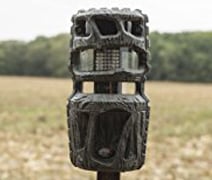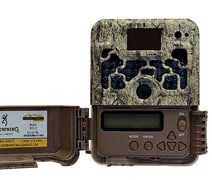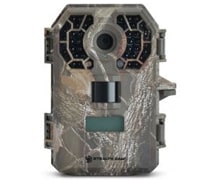Choosing the best deer trail camera involves more than picking up the first model you come across or buying the same one as your hunting buddy. You shouldn’t buy a game camera based on the cost alone, although pricing is important. Each deer trail camera is built to serve different purposes for hunters like you. Below, we’ll examine a few of the things you should consider when choosing a deer trail camera, and we’ll also explain why each detail matters.

How To Choose The Best Deer Trail Camera
Camera Clarity
The clarity of the photos a trail camera takes is determined by the number of megapixels. The higher the number of megapixels, the clearer photos will be. If you need a camera for general surveillance you might only require 6 or 8 megapixels, but individuals who want to track specific animals from long distances will likely want a camera with a rating of 10-14 megapixels.
Video Quality
Video quality is important to people who want to learn the movement patterns of specific deer in the area. If high-quality video resolution is important to you then you’ll want to invest in a trail camera with 720P or higher. Video length should also be taken into consideration because some cameras can record for 20 seconds at a time while others can record for two minutes or more.
Flash Capabilities
Flash technology for trail cameras has advanced significantly in recent years. Most people prefer a “black” or “ghost” flash, which uses dozens of LED lights to illuminate the photo without alerting the target to your camera’s presence. There are varying levels of infrared flash technology, and you can decide how important this feature is to you when choosing a deer trail camera.
Detection & Capturing Specifications
The distance that a camera can detect movement and capture photos/images is extremely important to hunters who want to observe a field or place their camera close to, but not directly on, a deer trail. Some game cameras are rated for up to 100 feet, but there are also more economical models available that are rated for 40-50 feet.
In addition to distance, the field of vision rating is key. A trail camera with a 40-degree field of vision, for example, won’t be able to detect as much movement as a camera with a 100-degree rating. Some trail cameras even offer a 360-degree field of vision and are mounted on poles to capture everything in every direction. Knowing where you plan to place the camera in relation to what you plan to track will help you determine how wide the camera’s field of vision needs to be.
Available Features & Options
Do you need a deer trail camera that simply sees movement and takes a picture, or do you need a camera with audio and/or time lapse mode capabilities, thus allowing you to track specific targets over a long period of time?
Do you need the ability to plug GPS coordinates into the camera? How important is knowing the date, time, temperature and moon phase of each photo/video to you?
Are features like picture clarity and video length adjustable, possibly allowing you to extend the battery life? How large of a memory card can the trail camera you’re considering accept?
Design
A trail camera’s design can make or break your ability to track game successfully. The casing should be durable, weather-resistant and waterproof, especially if the camera is to be used outdoors. Depending on your location, you might also want to consider trail cameras that can withstand extreme temperatures.
How long are the batteries designed to last? Is it possible to connect the camera to an external power source? A dead camera can spoil your efforts and force you to visit the camera’s location more often.
Many cameras also come with a camouflage design to make the camera less noticeable. You can also compare sizes and weights of different cameras if concealment is a high priority.
Manufacturer Reputation
Dozens of U.S. and overseas companies make deer trail cameras, but not all game cameras are created equal.
How long has a company been in business? Newer companies aren’t necessarily “bad” but the fact that a company has been in business for decades could be a good indication of customer satisfaction.
What do users of their products have to say? You can find reviews of the companies themselves as well as reviews for specific deer trail cameras online by conducting a simple Google search.
Does the manufacturer offer any sort of warranty or guarantee? It’s nice to know that if you do receive a defective product the company will stand by you.
Top 3 Deer Trail Camera Recommendations
1. Stealth Cam G42
This compact and well-designed deer trail camera comes with a lot of useful features at an affordable price. It has a 10 megapixel adjustable camera, shoots HD video (up to 180 seconds) and has time lapse mode. It has a trigger speed of just 0.5 seconds and it’s equipped with 42 Black Flash LEDs to illuminate the night without alerting anyone.
2. Wildgame Innovations 360
 The unique design of this game camera allows you to capture images (with a 12 megapixel camera) and videos (720P quality) in any direction and from up to 70 feet away. It has an infrared flash system, a 1.5 second trigger speed and accepts memory cards of up to 32 megabytes. As an added bonus, this camera can operate for up to six months on a single set of batteries.
The unique design of this game camera allows you to capture images (with a 12 megapixel camera) and videos (720P quality) in any direction and from up to 70 feet away. It has an infrared flash system, a 1.5 second trigger speed and accepts memory cards of up to 32 megabytes. As an added bonus, this camera can operate for up to six months on a single set of batteries.
3. Browning Strike Force Sub Micro
 This top-of-the-line offering from Browning features a 100-foot detection range and a lightning fast trigger speed of 0.67 seconds. It records audio and video (up to two minutes at a time) and is highly-regarded as one of the best game cameras for nighttime scouting thanks to its 100-foot infrared flash technology. It comes with a 10 megapixel camera and it has time lapse mode for long-term deer tracking.
This top-of-the-line offering from Browning features a 100-foot detection range and a lightning fast trigger speed of 0.67 seconds. It records audio and video (up to two minutes at a time) and is highly-regarded as one of the best game cameras for nighttime scouting thanks to its 100-foot infrared flash technology. It comes with a 10 megapixel camera and it has time lapse mode for long-term deer tracking.
Conclusion
We hope this brief tutorial on how to choose the best deer trail cameras is helpful. If you have any other tips or tricks that you use to compare game cameras, we’d love to hear from you and add your pointers to our list. Happy hunting!


Sharon Hinton says
Please give basic set up for VM-PIR110. Have camera with no cords but have SD card. We keep having our barn broken into at night. Thank you